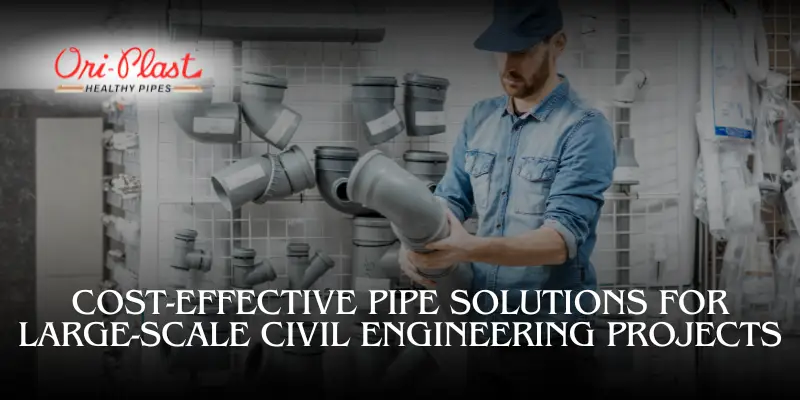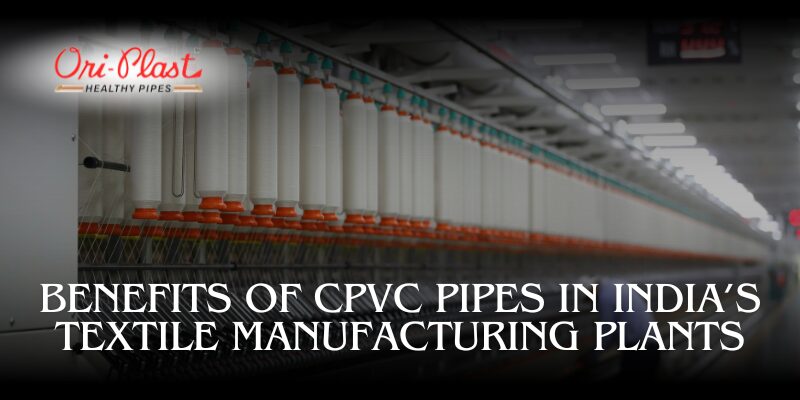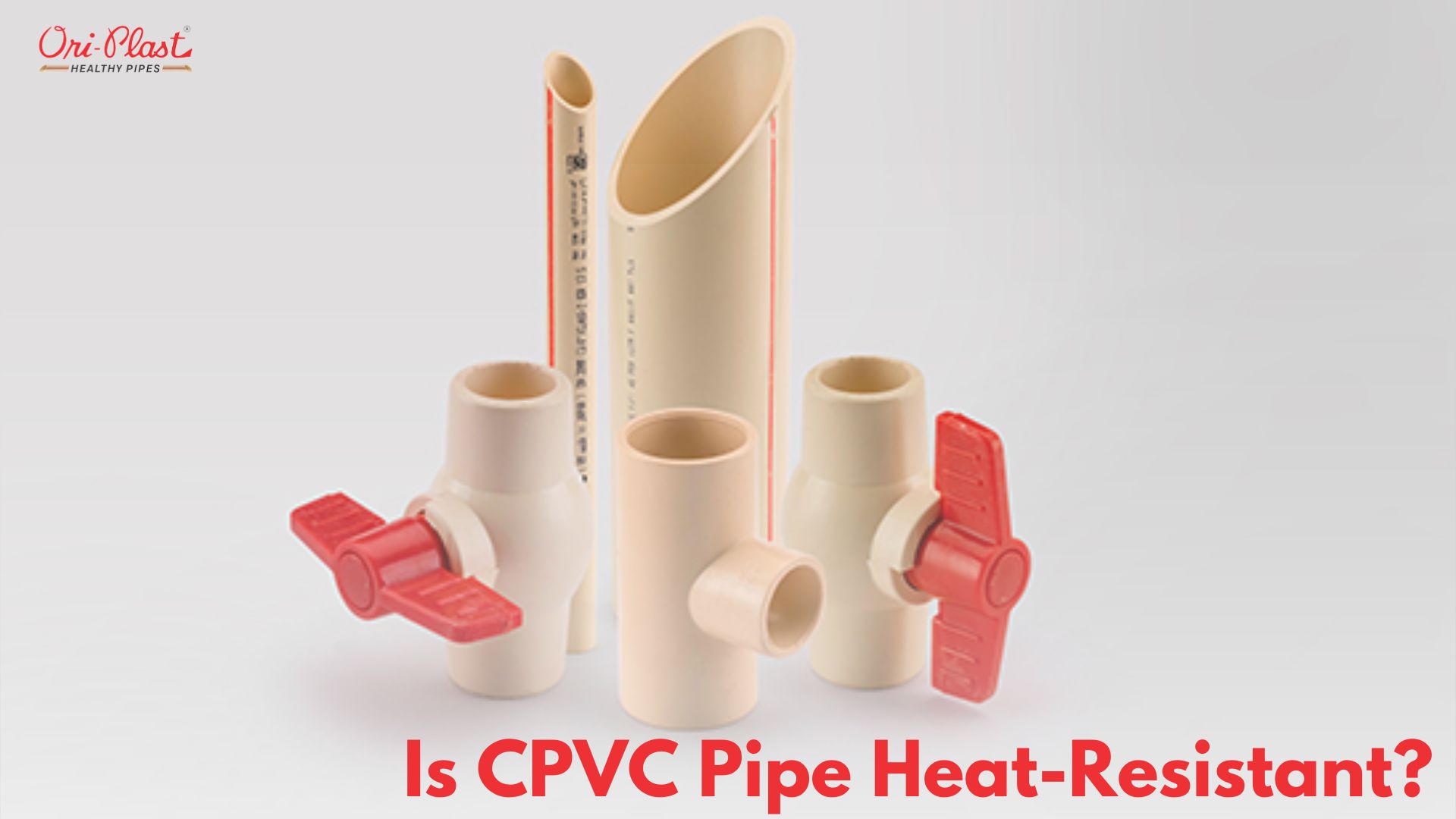CPVC Pipes and Fittings Guide
CPVC (Chlorinated Polyvinyl Chloride) pipes and fittings are a popular choice for plumbing projects due to their durability, ease of installation, and affordability.
However, it's important to use the correct materials when working on any plumbing project to avoid potential leaks and other issues.
The purpose of this article is to provide readers with a comprehensive guide on using CPVC pipes and fittings.
Whether you're a DIY enthusiast or a professional plumber, this guide will help you understand the basics of CPVC pipes and fittings and how to install, maintain, and repair them properly. Also, check out high-quality CPVC pipes & fittings here.
What are CPVC Pipes and Fittings?
CPVC (Chlorinated Polyvinyl Chloride) pipes and fittings are made of a thermoplastic material that is highly durable, resistant to corrosion, and can withstand high temperatures and pressure.
They are commonly used for hot and cold water supply systems, industrial piping, and fire sprinkler systems.
Advantages of Using CPVC Pipes and Fittings:
- High temperature and pressure resistance
- Durability and corrosion resistance
- Easy to install and maintain
- Affordability compared to other materials
- Long lifespan
- Environmentally friendly
Types of CPVC Pipes and Fittings:
- CPVC Pipes: available in different sizes and thicknesses
- CPVC Fittings: elbows, couplings, tees, and other fittings are available for connecting and branching pipes
- CPVC Valves: ball valves, butterfly valves, and other valves are available for controlling the flow of water or other fluids in the system
- CPVC Adhesives: solvent-based adhesives are used to bond CPVC pipes and fittings together, ensuring a leak-free system.
Overall, CPVC pipes and fittings are an excellent choice for various plumbing applications due to their versatility, durability, and affordability.
Tools and Materials Required for Working with CPVC Pipes and Fittings
Before starting any plumbing project, it's essential to gather all the necessary tools and materials. Here are the tools and materials required for working with CPVC pipes and fittings:
- CPVC Pipes and Fittings: These are the main components of the plumbing system.
- CPVC Adhesive: A solvent-based adhesive used to bond CPVC pipes and fittings together. It's essential to use the correct adhesive for the specific type of CPVC material.
- CPVC Primer: A solvent-based primer used to prepare the surface of the CPVC pipes and fittings before applying the adhesive. The primer ensures a secure and long-lasting bond.
- Measuring Tape: Used to measure the length of the pipes and fittings accurately.
- Hacksaw or Pipe Cutter: Used to cut the CPVC pipes and fittings to the required length.
- Sandpaper or Emery Cloth: Used to smooth the edges of the cut CPVC pipes and fittings to remove any burrs or sharp edges.
- Deburring Tool: Used to remove any internal burrs or sharp edges from the cut pipes and fittings.
- Adjustable Wrench or Pliers: Used to tighten the CPVC fittings securely.
- Safety Equipment: Safety glasses, gloves, and a dust mask are essential safety equipment to protect against the fumes and dust generated during the cutting and bonding process.
It's important to use the correct tools and materials and follow safety guidelines when working with CPVC pipes and fittings. By doing so, you'll ensure a safe and leak-free plumbing system.
Steps for Installing CPVC Pipes and Fittings
Here is a step-by-step guide for installing CPVC pipes and fittings:
Step 1: Plan the Plumbing System
Plan the plumbing system, including the layout, the number of pipes, and the fittings required.
Step 2: Cut the CPVC Pipes and Fittings
Measure and mark the pipes and fittings to the required length. Cut the pipes and fittings using a hacksaw or pipe cutter.
Step 3: Smooth the Edges
Use sandpaper or emery cloth to smooth the edges of the cut pipes and fittings to remove any burrs or sharp edges.
Step 4: Clean the Pipes and Fittings
Use a cloth to clean the pipes and fittings. Apply a CPVC primer to the surfaces of the pipes and fittings that will be bonded together.
Step 5: Apply the CPVC Adhesive
Apply a small amount of CPVC adhesive to the surfaces of the pipes and fittings that will be bonded together. Insert the pipe into the fitting and twist it slightly to ensure a proper fit.
Step 6: Hold the Pipes and Fittings in Place
Hold the pipes and fittings in place for a few seconds to ensure a secure bond.
Step 7: Repeat the Process
Repeat the process for all the pipes and fittings in the plumbing system.
Step 8: Allow the Adhesive to Dry
Allow the adhesive to dry for at least 30 minutes before turning on the water supply.
Potential Challenges and How to Overcome Them:
Fitting Alignment: It's important to ensure that the fittings are aligned correctly before bonding them together.
To overcome this challenge, dry-fit the pipes and fittings to ensure a proper fit before applying the adhesive.
Cold Weather Installation: CPVC pipes and fittings are prone to cracking in cold weather. To overcome this challenge, warm the pipes and fittings with a heat gun or warm water before installation.
Removing Glued Fittings: If you need to remove a glued fitting, use a heat gun to soften the adhesive and then gently twist the fitting to remove it.
By following these steps and overcoming potential challenges, you can install a leak-free and durable plumbing system using CPVC pipes and fittings.
Tips for Working with CPVC Pipes and Fittings
Working with CPVC pipes and fittings requires precision and attention to detail. Here are some tips to help you work with CPVC pipes and fittings effectively:
Measure Twice, Cut Once:
It's essential to measure the length of the pipes and fittings accurately. Measure twice to ensure that you have the correct length before cutting. This will save time and prevent wastage.
Use the Correct Adhesive:
Using the correct adhesive is crucial for bonding CPVC pipes and fittings together. It's important to use an adhesive that is compatible with the specific type of CPVC material.
Follow the Manufacturer's Instructions:
Always follow the manufacturer's instructions for using the adhesive and primer. This will ensure a secure and long-lasting bond.
Use Safety Equipment:
Wear safety glasses, gloves, and a dust mask when cutting and bonding CPVC pipes and fittings. This will protect against the fumes and dust generated during the installation process.
Avoid Common Mistakes:
Some common mistakes to avoid include applying too much or too little adhesive, not allowing the adhesive to dry properly, and using the wrong type of primer or adhesive.
Use Proper Installation Techniques:
It's important to use proper installation techniques to prevent leaks and ensure the durability of the plumbing system. Use the correct fittings, avoid over-tightening, and ensure that the pipes are properly supported.
By following these tips and techniques, you can work with CPVC pipes and fittings effectively and install a reliable plumbing system.
Maintenance and Repair of CPVC Pipes and Fittings
Maintaining CPVC pipes and fittings is essential for ensuring the longevity and reliability of your plumbing system. Here are some tips for maintaining and repairing CPVC pipes and fittings:
Inspect the Plumbing System Regularly:
Regularly inspecting the plumbing system can help identify any potential issues before they become major problems. Look for signs of corrosion, leaks, and damage to the pipes and fittings.
Clean the Pipes and Fittings:
Cleaning the pipes and fittings can help prevent blockages and ensure the smooth flow of water through the plumbing system. Use a mild detergent and warm water to clean the pipes and fittings.
Replace Damaged Pipes and Fittings:
If you notice any damage to the pipes and fittings, it's essential to replace them immediately. Damaged pipes and fittings can cause leaks, which can lead to water damage and mold growth.
Troubleshoot Common Issues:
Some common issues that may arise with CPVC pipes and fittings include leaks, blockages, and damage. Troubleshoot these issues by identifying the source of the problem and addressing it accordingly.
For leaks, inspect the pipes and fittings for damage and replace any damaged components. Also, ensure that the fittings are tightened properly.
For blockages, use a plunger or drain cleaner to clear the blockage. Avoid using harsh chemicals that can damage the pipes and fittings.
For damage, replace the damaged pipes and fittings immediately to prevent further damage to the plumbing system.
By following these maintenance and repair tips, you can keep your CPVC pipes and fittings in good condition and avoid costly repairs in the future.
Conclusion
In conclusion, using CPVC pipes and fittings for plumbing projects has several advantages, including durability, cost-effectiveness, and ease of installation.
This comprehensive guide has provided you with the information you need to work with CPVC pipes and fittings effectively.
Remember to use the correct tools and materials, follow the manufacturer's instructions, and use proper installation techniques to ensure a reliable plumbing system.
Additionally, maintain and repair the plumbing system regularly to prevent issues from arising.
Oriplast is a leading PVC pipe manufacturer in Kolkata, known for its high-quality products and excellent customer service.
By choosing Oriplast, you can be confident that you are using the best materials for your plumbing project.
We encourage you to follow this guide and seek professional help if needed to ensure a successful plumbing project. By taking these steps, you can have peace of mind knowing that your plumbing system is durable, reliable, and built to last.
Visit Oriplast Facebook Page For More...




